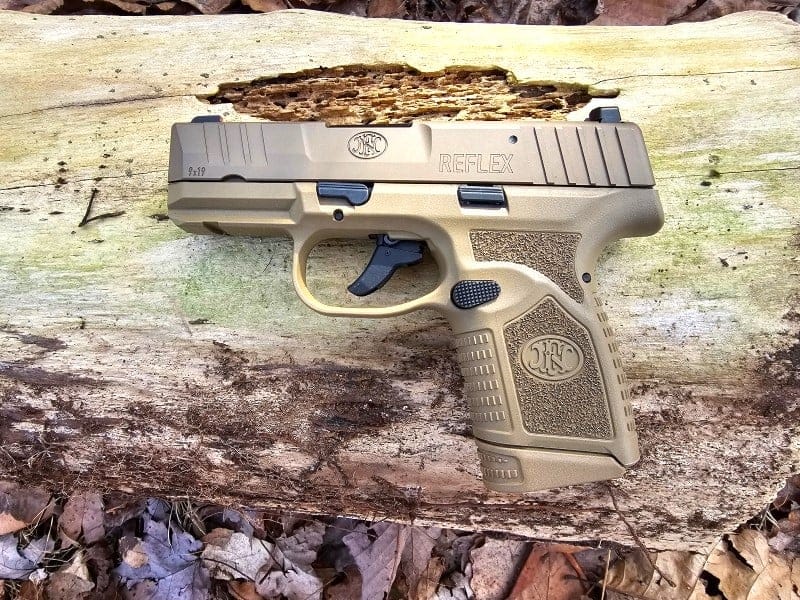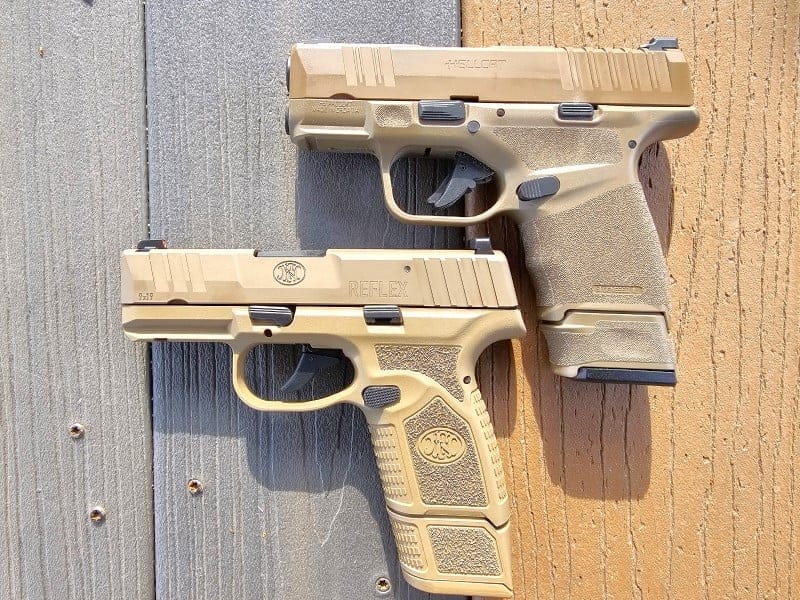Today, we’ll be pitting two micro-9mm pistols – the Springfield Hellcat and the FN Reflex – against each other to consider their differences and attributes. After we put them through their paces, we’ll declare a winner. You will likely be surprised at who the winner is; the decision is very clear-cut for me.
We’ll look at their technical specifications, compare them, and then see how they performed on the range.
I’ve owned the Hellcat for over a year now and only recently bought the Reflex. In full disclosure, Springfield Armory sent me the Hellcat for a review, but I decided to purchase it from them. I bought the FN Reflex at my local gun shop. I bought and paid for both pistols; no freebies were involved.
Springfield Armory Hellcat Specs
The Springfield Armory Hellcat is a 9mm pistol with a 3-inch forged steel barrel and a Melonite finish. The slide is billet machined, and mine has a Flat Dark Earth Cerakote finish.
The overall length of the pistol is six inches, and the weight is 18.3 inches with the flush-fit magazine. Height is four inches with the flush fit magazine. The width is one inch.

The frame is polymer and is colored in FDE. The grip width is one inch. Grip texturing is Springfield’s Adaptive Grip Texture, which I’d describe as having a texture that’s close to sandpaper. Once the shooter locks his or her hand around the grip, it’s not going anywhere because of the abrasive texture of the grip.
This is a striker-fired pistol.
FN Reflex Specs
The FN Reflex has a 3.3-inch cold hammer-forged barrel and weighs 18.4 ounces. Its overall length is 6.2 inches, its height is 4.27 inches, and its width is one inch.

The Reflex uses a polymer frame with a very interesting grip that has two different textures.
This is a hammer-fired, Single Action Only (SAO) pistol. That’s not a typo. The hammer is completely internal, so many people just assume it’s a striker-fired pistol like all the other micro-9s on the market.
Magazines
The Hellcat has numerous magazine options available to the platform: 11, 13, 15, and 17-round magazines. Each comes with a different floor plate/extension, some of which lengthen the grip. I’ve found the 13-round magazine to be perfect because it slightly extends the grip both fore and aft just enough to get a perfect grip while not making it too long for concealment. And having 13+1 rounds in the pistol is a comfort. The 15- and 17-round grips are great as spare magazines and give serious capacity to the Hellcat.

Magazine selection for the Reflex is more simple: 11 and 15 rounds. The 11-round magazine isn’t bad and has an extension on the front of it for the little finger to rest, which is good. However, the rear of the grip is still unsupported and isn’t the most comfortable grip in my hand. The 15-round magazine is excellent for range accuracy and gives full support to the grip. However, the 15-rounder might be slightly long for regular carry for most folks. FN would be wise to introduce a 13-round magazine like Springfield did.
Grips
Both pistols have great grips. They are very different from each other, but each is unique and feels good.
The sides of the Reflex grip are stippled, and the texture is rough, which gives a good purchase in the hand. The front and rear of the grip feature squares that protrude and press into the skin when the shooter’s grip is tightened. Between these two different textures, the Reflex really gets locked into the shooter’s grip. I dare say it’s one of the best grips I’ve ever experienced. Aside from being comfortable, it also has an interesting appearance that’s attractive and it adds an element of sophistication to the pistol.

The Hellcat’s grip isn’t as complex, but it still functions very well. In fact, the grip is a major reason why I chose to buy the Hellcat. The dimensions are outstanding and perfect for my hand. As mentioned, the grip’s texturing is very aggressive, and when the shooter squeezes the grip, it really locks the pistol into the hand. Even with wet hands, there’s no way the grip is going anywhere when it is squeezed.
Triggers
Like many other striker-fired pistols, the Hellcat’s trigger has a long take-up before it hits the wall. The wall is firm, and it breaks very cleanly. Overall, I like this trigger a lot, mostly because of its crisp break.
The Reflex’s trigger has a bit of take-up, but it is extremely light. The difference here is that it’s not cocking a striker because it is hammer-fired. The hammer is cocked when the slide is racked, so pulling the trigger does not cock the hammer since that has already been done. The break is crisp and light (lighter than the Hellcat’s trigger).
Overall, I really like both triggers. The Reflex’s break is lighter, but I think the Hellcat’s break is more crisp. I’d say the Reflex’s trigger lends itself better to accuracy.
For a defensive pistol, I’d rather have the Hellcat’s slightly heavier trigger. When the adrenaline is flowing, we sometimes get a little overzealous on the trigger, and it’s easy to press a light trigger when we don’t intend to. That’s why there are fewer negligent discharges with revolvers or double-action-only pistols.
Sights
Sights on the Reflex are of excellent design metal 3-dot configuration. There are two white dots in the rear, with a front white dot on the post. The white dot is tritium, which is supposed to glow at night. Surrounding the tritium dot is an orange circle that is high visibility and very easy for the eye to pick up. I like these sights a lot. Except there was one glaring (or rather, not glaring) problem: the tritium on my pistol was totally dead. It wouldn’t even give a slight glow in pitch blackness. I had this verified by a few other people because I thought maybe there was something wrong with my eyes.
All, however, verified that there was absolutely zero luminescence coming from the tritium in that sight. Evidently, quality control is slipping at FN. It’s not a deal-breaker, but it’s disappointing. I contacted FN, but I have yet to hear any response from them as I pen this article.

The Hellcat’s sights are also made of metal and have a superior design. The rear sight sports a U-notch design outlined in white, while the front sight features a green tritium dot (that actually glows in low light) surrounded by a white circle. The U-notch really draws the front circle down into it, and the sights just work well together. These are some of my favorite sights of any pistol on the market.
At The Range
The proof is in the pudding, so we retired to the range to compare both pistols.
The Hellcat, which I’ve owned for well over a year, functioned perfectly with a variety of ammo. Accuracy is perfectly acceptable at realistic distances. I’ve even shot it out to 75 yards, and it can make hits on man-sized targets at that range. The sights are so easy to see, which really helps to acquire them quickly.
The muzzle flip on both pistols is approximately the same, so it’s hard to give a nod one way or the other since both are about equal. As an aside, most of these small micro-9mm Luger pistols are a bit snappy when fired, so there’s going to be a little more muzzle flip than on larger pistols.
The accuracy edge leans slightly in favor of the FN Reflex, as it’s a very accurate pistol. The sights are easy to pick up, with that orange front dot being a great addition to the pistol.
Unfortunately, my FN Reflex is not a reliable pistol; I was having numerous failures to feed despite trying a few different brands of ammunition. The rounds were hanging up and did not want to feed into the chamber, although it didn’t seem to be a feed ramp issue. I’m not sure what’s going on, but again, it appears that the quality control at FN is not up to snuff, which is extremely disappointing. I expected that a pistol with this pedigree would at least be reliable if nothing else.
Granted, this is a “control group” of one, so it’s definitely not a scientific test, and perhaps I received a lemon. Nevertheless, my attitude toward FN is less than sterling.
Final Thoughts
Sadly, I cannot recommend the FN Reflex due to the reliability issues that I experienced. And the fact that the front sight’s tritium is completely dead also doesn’t paint a flattering picture, although that issue should be resolved easily enough. Still, what good is a glowing front sight when you’re faced with constant feed stoppages?
For as long as it took FN to get into the Micro-9 game, we expected the finished product to be 100% reliable.
Springfield Armory’s Hellcat is the clear winner in this contest due to its reliability. Also, the Hellcat is more versatile because a much wider variety of magazines are available for it.


